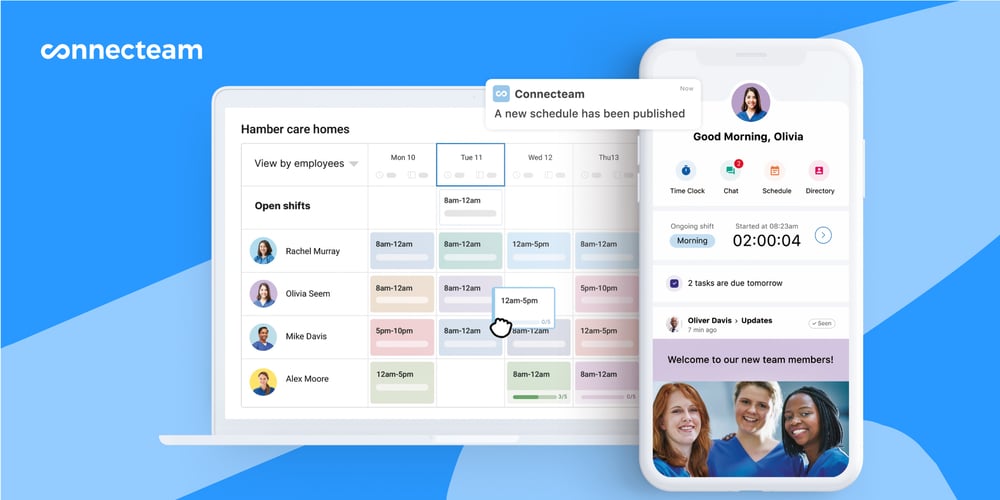Creating an effective on-call schedule for your team can be challenging and time-consuming. It can be tough to make sure employees’ workloads are distributed fairly and they have enough rest time between regular and on-call shifts. Finding a balance between team member availability, skills, and seniority is difficult, too.
With a well-planned schedule, your team will be prepared to handle emergencies and unexpected issues outside of regular business hours. An effective schedule can also boost morale, prevent burnout, and improve customer relations.
In this guide, we look at how on-call scheduling works and share 11 top tips for creating one to meet your organization’s needs.
What Is On-Call Scheduling?
An on-call schedule sets out which employees will be available to deal with emergencies outside of business hours.
When a worker is on call, they’ll typically need to respond to a request to work at short notice. This could potentially be at any time of the day or night.
You may need an on-call schedule if you have to have 24/7 assistance or operations available to your customers, or if your business relies on keeping certain key equipment running at all times.
Industries that often require this type of schedule include:
- Plumbing
- Electricians
- Home security
- Healthcare or emergency services
- Service industries—additional staff may be needed during busy periods.
On-call workers normally need to be available over the phone or through messaging apps. They may also need to respond within a certain timeframe.
As an employer, you might be required to pay your workers a higher rate of compensation when they’re on call.
Choosing the Right Scheduling Model
There are many different types of work schedules you could use to build your on-call schedule. The most common types of on call schedules include:
Rotating scheduled employees
With an on-call rotation schedule, your workers take turns responding to emergencies. This avoids relying on the same employees to take on the responsibility for on-call work.
For example, you may have a group of employees on call for one week. These workers will then return to their regular shifts the following week, and another group will be on call. A rotating schedule may change on a daily, weekly, bi-weekly, or monthly basis.
Primary/secondary contacts
The type of scheduling establishes a primary point of contact for emergency calls. A secondary contact will step in if the primary contact isn’t available or can’t fix the problem. This model is particularly useful if several emergencies often arise at the same time within your business.
You may decide to pair two employees together and alternate the roles of primary and secondary points of contact. For instance, one employee would be the primary contact one week, and the other the following week.
Week/weekend
Under this model, you divide your employees into two on-call groups. One will be on call during the week, and the other at weekends.
Follow-the-sun
The follow-the-sun model sets your workers’ schedules based on their locations. Employees are typically on call during daylight hours in their region. This system may be appropriate for global businesses, with employees based in different parts of the world.
Expert support
This type of scheduling allows you to provide specialist support in particularly difficult situations. It allows your regular on-call duty workers to escalate a problem to a designated expert when they’re unable to solve it themselves.
On-call experts are often your most experienced workers or those with specialist qualifications. They’ll typically handle problems that may be too complicated for other, less-skilled workers to fix. They may, for example, work with machinery or tools that require specialist knowledge. This could include someone like a plumber or an on-call engineer.
How Much Does On-Call Scheduling Cost?
Before you implement on-call scheduling into your operations, it’s important to understand the cost. The cost goes beyond basic pay, since you need to factor in both the direct expenses on payroll and the indirect ones that can come from turnover, reduced productivity, and compliance risks.
Direct costs
Direct costs are the easiest to calculate, and include on-call pay (flat fee or hourly), overtime when staff work beyond 40 hours, call-out pay for last-minute shifts, and technology like scheduling software.
Indirect costs
Hidden costs can be even more damaging, because on-call duties may lead to burnout and turnover, which come with replacement and training costs. When your employees are tired from being on-call, it can result in lower productivity. With less responsive employees, you risk dissatisfied customers. More than that, if you don’t pay close attention, you could violate labor laws, which involves its own set of financial fees.
Sample cost breakdown
Let’s take a look at what on-call scheduling could cost you. In this example, note that indirect costs account for more than 30% of the total. That’s why focusing only on direct pay significantly underestimates the true expense.
| Cost Item | Calculation | Annual Cost |
| On-Call Pay | 5 employees × 1 week/month × 168 hrs/week × $5/hr | $50,400 |
| Overtime Pay | 5 employees × 2 hrs/week × 52 wks × $37.50/hr | $19,500 |
| Call-Out Pay | 5 employees × 1 call/week × 52 wks × 2 hrs × $37.50/hr | $19,500 |
| Turnover Costs | 1 turnover/year × $50,000 salary × 50% replacement cost | $25,000 |
| Lost Productivity | 5 employees × 5% productivity loss × $50,000 salary | $12,500 |
| Total Annual Cost | – | $131,900 |
Reducing your costs
There are a few ways you can control on-call costs, including:
- Using a tiered response system so skilled staff aren’t dealing with minor issues.
- Using a follow-the-sun model to spread work across time zones.
- Cross-training employees to prevent burnout and improve employee satisfaction.
- Using technology to automate scheduling, reduce call volume, and streamline communication.
11 Tips for Creating an On-Call Schedule
The best scheduling method for your business will depend on your team size and the industry you work in. However, there are certain tips that can help all businesses create on-call schedules that work for employees and customers.
Determine your cover needs and on-call budget
When you’re drawing up an on-call schedule, the first step is to decide when you may need cover and how much you’re likely to need.
Once you have a clear idea of your needs, you can draw up a schedule and allocate a budget for on-call support.
Decide what constitutes an emergency
As a business owner, you’ll want to provide your customers or clients with the best your company can offer. However, it’s also important to consider the well-being of your on-call employees.
Agreeing on the definition of an emergency situation will prevent your workers from frequently being disturbed at inconvenient hours, like in the middle of the night.
Develop a clear definition of “on-call”
Working with your employees to determine what exactly it means for them to be “on-call” can help you avoid misunderstandings in the future.
Here are some examples of what ground rules you should clarify in your definition.
- How often your employees need to be on call.
- The start and end times of their shifts.
- The types of situations they may need to respond to.
- The communication methods on-call employees need to use—for example, being available by phone or email.
- Expected response times.
- On-call pay rate.
It may also be helpful to remind your employees of the reasons they need to be on call from time to time.
Factor in employee preferences
On-call working is more likely to be successful when it takes employees’ wishes and needs into account.
For example, workers with children may find it difficult to be on call during school vacations. Other employees may have religious beliefs that mean they can’t be on call on certain days. On the other hand, some team members may welcome the opportunity to work on-call shifts whenever possible, as it can allow them to earn extra money.
It’s also important to honor your employees’ time off requests when creating your on-call schedule.
This kind of flexibility can greatly benefit employer-employee relations. It shows that you value your workers as people with lives outside of work. In return, your employees are more likely to accommodate your requests for them to work different shift patterns.
You might want to go over our in-depth comparison of the Best On-Call Scheduling Software in 2026.
Consider your employees’ individual strengths
As a people manager, you have an understanding of your employees’ strengths and weaknesses. For example, some of your workers may have first-rate technical skills, while others can build a great rapport with customers.
Using this knowledge will make you an effective on-call scheduler. Considering your employees’ unique attributes will help you dispatch the most suitable employees to your on-call jobs.
Make sure your employees have enough time off for a good work-life balance
In addition to honoring your employees’ time off requests when creating your on-call schedule, ensure that the schedule allows your team members to take sufficient time off and have paid holidays.
Shift-planning software can give you an overview of your employees’ working patterns. Having this information available at a glance can allow you to spot employees who are working long or difficult schedules.
Similarly, you can also check in on employees’ work-life balance during regular one-on-one conversations and adjust your schedule as needed to prevent overworking and potential burnout.
Employees who are exhausted from working unsociable hours or many night shifts in a row may look for employment elsewhere. Having an effective on-call strategy is crucial for your company’s retention strategy.
Treat team members equally and fairly
Applying the same approach to scheduling all your on-call team members is essential to ensuring a happy and productive workplace. Make sure that you aren’t regularly scheduling the same employees to be on call or not assigning certain employees to on-call shifts.
Showing favoritism when assigning out-of-hours work could damage morale. Likewise, relying on the same employees to regularly be on call can lead to burnout and also affect your employees’ physical well-being.
Being open with your employees about how you have created your schedule is helpful. Explaining why you’ve chosen particular employees to be on call can increase transparency across your team and help prevent disagreements in the future.
Post schedules well in advance
Giving your workers adequate notice of their on-call hours can be crucial to their job satisfaction. It will help employees avoid conflicts with their non-work commitments, such as childcare or medical appointments.
Your team members may find it difficult to achieve a healthy work-life balance if they don’t receive proper notice of their schedules. Routinely working at short notice could also mean they miss important celebrations or struggle to spend time with family. This situation could lead to resentment, damage morale, and reduce employee engagement levels.
Offer an emergency support number for on-call workers
No matter how effective your on-call scheduling system is, unforeseen difficulties can arise.
For instance, your on-call workers may suffer their own emergencies and be unable to work. This could happen for several reasons, including illness or a vehicle breakdown. In extreme circumstances, your employees may find a dangerous or threatening situation when they arrive at an on-call job site.
It’s important to have a dedicated point of contact for your on-call staff. This could be through a phone number, a group messaging service, or a chat app built into your employee team communication software solution.
Regularly review your approach to scheduling
For your on-call schedule to be a success, you’ll need to make sure that it can work in the long term. Seeking feedback from your employees and customers or clients can be an effective way of doing this.
Ask your workers how they’re finding the experience of being on call and consider if you need to make any changes to your schedule. For example, you could investigate alternative shift patterns for an employee if their on-call hours conflict with their life outside of work.
Seeking feedback from customers or clients is equally important. You can do this through surveys, polls, emails, or simple phone calls. Then, review the feedback and make appropriate changes to your on-call schedule to address any concerns.
For example, you can add more experienced members of staff to your on-call schedule. This helps ensure your team provides adequate support during an emergency. Or, you can introduce a primary/secondary on-call scheduling system. This way, your company can handle several incidents at once and customers won’t wait too long for a response.
Use Connecteam to Simplify Your On-Call Schedules
On-call scheduling software automates repetitive tasks like shift creation, time-off requests, and communication. These platforms reduce errors, save time, and improve team accountability. Key features include:
- Shift automation to handle rotations, recurring shifts, and open shifts.
- Time tracking with overtime alerts and break management.
- In-app communication to notify staff of changes instantly.
- Self-service tools for shift swaps and managing availability.

Connecteam, an all-in-one employee management tool, offers all those features and much more. The scheduling app is built to help you create and manage your on-call schedule efficiently. It’s easy to build rotating schedules, manage employee availability, and track attendance. Team members can request time off, swap shifts with ease, and claim open on-call shifts.
Use the AI scheduler to fairly assign employees to unfilled shifts in seconds, based on their availability, role, preferences, and qualifications. Connecteam detects scheduling conflicts and even alerts managers when employees are approaching overtime.
Automatically send your staff reminders about upcoming shifts, and include notes, checklists, tasks, and anything else your team needs to succeed to every shift. The best part? Your team can access their schedules right from their mobile devices, so they always know where and when they’re working.
Connecteam’s Small Business Plan is completely free for up to 10 users. Paid plans include flat-rate pricing that starts at $29/month for up to 30 users, which is ideal for small businesses trying to keep costs down. There’s also a 14–day free trial. So what are you waiting for?
Try Connecteam for free today!
Understanding the Law
There are a few key legal considerations for on-call scheduling that you should know. These include:
On-call vs. standby time
In the US, the Fair Labor Standards Act (FLSA) regulates pay and working conditions for non-exempt employees. Any time your workers spend on-call at your business generally counts as hours worked and must be paid. If staff are offsite but must follow certain restrictions, such as staying near the workplace or answering calls, this also counts as on-call time, and they likely need to be compensated.
Standby time, on the other hand, is where employees are free to use their time as they wish, without restrictions; they only need to respond if they’re contacted. This is usually not paid.
Under the FLSA, misclassifying on-call time as unpaid standby time can lead to major compliance issues, back pay claims, and fines. Always know the degree of restriction placed on your employees so you know if they are entitled to compensation.
Overtime rules
Overtime also falls under FLSA jurisdiction. You need to follow FLSA overtime rules, which mean that any hours non-exempt employees work beyond 40 per week must be paid at 1.5 times their regular rate.
Find more information on rules in your specific state in our State Labor Laws guide.
This Might Interest You
Famous On-Call Schedule Examples:
Flight Attendant Schedules: How do they work?
Firefighter Schedules: How do they work?
Summary
Having on-call workers may be necessary if your line of work can involve emergencies at any time of day or night, or if your business requires additional staff during busy periods.
A well-organized on-call system can ensure that you deliver high-quality service to your customers or clients. It also improves employees’ work-life balance, improves their engagement, and reduces turnover.
There is no one size fits all approach to scheduling. For effective on-call scheduling, have an open conversation with your team members so you can understand their specific needs and availability and they know what you expect from them.
When creating the schedule, consider different scheduling patterns like call rotations and ensure your workers have enough time off between shifts. Treat team members equally when assigning shifts and regularly review and adjust your schedule based on feedback.
Lastly, use a dedicated employee scheduling app to ensure you always have the right workers for every job.
Get started with a free 14-day trial of Connecteam now!
FAQs
How to use software to manage on-call schedules?
Use on-call scheduling software to assign shifts, automate rotations, and send real-time notifications. Tools like Connecteam make it easy to centralize schedules, reduce errors, and ensure consistent coverage.
How do I handle on-call scheduling during holidays or peak seasons?
Handle holiday or peak-season on-call schedules by planning early, offering incentives, and rotating fairly. Use software like Connecteam to balance workloads and prevent burnout.
How can I track on-call hours accurately?
Digital time-tracking tools like Connecteam help you track on-call hours by logging availability, active hours, and payroll data. Use automated reports to ensure accuracy and compliance.
What are the best practices for communicating on-call schedules to employees?
Best practices include publishing schedules in advance, sending reminders, and using mobile apps like Connecteam so employees have instant access to updates.
How can I integrate on-call scheduling with other HR and operational systems?
Integrate on-call scheduling using APIs, payroll and HR software integrations, or workforce platforms that sync attendance, compliance, and reporting in one system.
What are the key performance indicators (KPIs) for on-call scheduling effectiveness?
Key KPIs include response times, shift coverage rate, overtime costs, employee satisfaction, and service outcomes during on-call times.
How do I calculate the ideal number of on-call personnel?
Calculate on-call staffing by looking at demand patterns, average call volume, response requirements, and legal limits. Adjust your numbers seasonally to ensure coverage.
What are common mistakes to avoid when creating an on-call schedule?
Avoid mistakes like unfair shift distribution, last-minute changes, unclear policies, and ignoring employee preferences. These can all lead to burnout, poor coverage, or even turnover.



